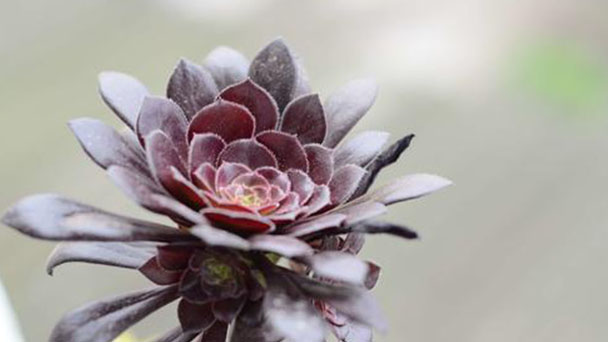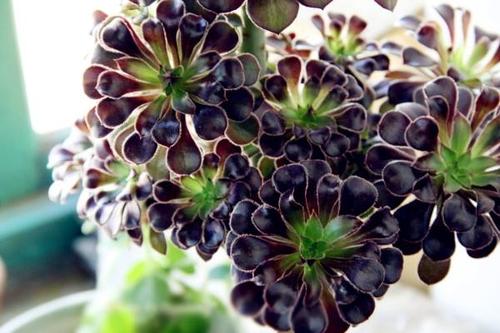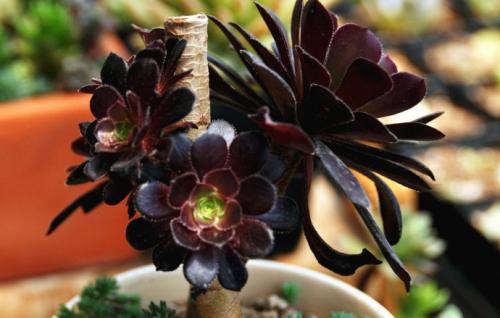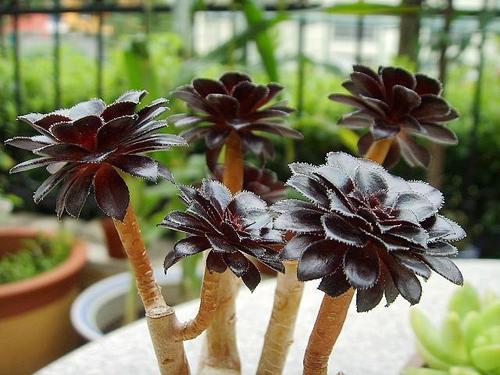How to grow Aeonium Zwartkop
Written by Maggie
Mar 17 2021

Aeonium 'Zwartkop' shape of a lotus and its dark color make it dignified and noble.So how to breed Aeonium 'Zwartkop' with such beauty? We just need to give it fertile soil, plenty of light, the right amount of water, the right temperature and a certain amount of fertilizer, and change the soil regularly.Finally, pay attention to disease and insect control when curing, and create a beautiful Aeonium 'Zwartkop'.

Aeonium 'Zwartkop' is one of the most popular succulents
1. Six breeding methods of Aeonium 'Zwartkop'
1. Fertile soil
Aeonium 'Zwartkop' requires fertile and well-drained, loose and breathable acid soil.Generally mixed with sandy loam, humus, peat, sand and gravel, to ensure its water permeability to prevent root rot, but also to give the plant rich nutrition.Aeonium 'Zwartkop' needs a lot of fertility to ensure its color is dark and shiny, otherwise it will be ugly with varying shades.
2. Get plenty of light
Aeonium 'Zwartkop' grows mainly in spring, summer, and fall, and sufficient sun exposure should be ensured during this period.Lack of sunlight in Aeonium 'Zwartkop' results in browning and green leaves, sub healthy plants, and imperfect colors.Therefore, the key to maintaining beauty in Aeonium 'Zwartkop' is sufficient light. When curing a black rose, avoid placing it in an astigmatic environment for a long time.
3. Keep hydrated
Aeonium 'Zwartkop' has poor water storage capacity, and should always keep the soil moist even during the dormant period in summer. Water should be irrigating every ten days or so, and it is best to do it at night.In the spring and autumn, watering the right amount, once a week is appropriate.Convenient and timely supplement of water is needed for plant development.In winter, you can choose to water in the sunny noon, once a month to prevent freezing or flooding.
4. Fertilize as needed
The demand for fertilizer in Aeonium 'Zwartkop' depends on how it grows.In the flowering period we should increase the use of phosphorus and potash fertilizer, to ensure the nutrition needed for flowering.Nitrogen should be added during the potting phase.However, if nitrogen fertilizer is excessive in the growth period, Aeonium 'Zwartkop' will cause light color and long branches and leaves. Therefore, microbial agents should be used to replace nitrogen fertilizer in normal curing.

5, the temperature is appropriate
Aeonium 'Zwartkop' prefers warm, dry and drought-resistant.The best temperature for growth is 20 ~ 25℃, and not cold resistant.Therefore, in winter we should strengthen to prevent cold and keep warm, moving indoor to avoid leaf frostbite water.In the dry summer, the leaves will wither due to water evaporation, so pay attention to shade, sunscreen, ventilation.
6. Change soil
Aeonium 'Zwartkop' is a plant in sedum and should not be used to change soil in midsummer.In addition to the summer dormant period, we can be in the cool dry spring, autumn, winter for basin, and once every 1 ~ 2 years is the best.When changing the basin, the soil ball should be taken to avoid damaging the root system, while keeping the soil fertile and good drainage.
Aeonium 'Zwartkop' cutting propagation
Due to low leaf insertion and propagation survival rate, Aeonium 'Zwartkop' is generally used for cutting propagation.We mostly choose to carry out in March ~ May when everything is revived, and the best temperature is 15 ~ 25℃.Cuttings need to pick robust full, well-developed branches and leaves inserted into the moist nutrient soil, and then cover the thin soil, waiting for 15 ~ 25 days will root.Pay attention to ventilation and astigmatism during waiting to avoid high temperature and waterlogging.

Aeonium 'Zwartkop' disease and insect control
1. Leaf spot
Leaf spot disease is a common disease in Aeonium 'Zwartkop'. It spreads in many ways and is highly contagious, and can occur all year round.From August to September is the most prevalent time for leaf spot disease, so we need to pay attention to prevention and control. Once found, 50% carbendazine 1000 times liquid can be sprayed for elimination.
2. Black weevil
The wraiths eat Aeonium 'Zwartkop' branches and leaves. If damaged, the plants will suffer severe damage, which will not only hinder Aeonium 'Zwartkop growth, but also affect aesthetics.So when we found this bug, we immediately removed the leaf, and then sprayed it with a 75% chlorothalonil wettable powder 800 times solution.

Latest Updated
- Benefits of Bugleweed - 7 Science-backed Health Benefits
- Bugleweed Dangers & Side Effects - Is It Poisonous?
- How to Plant Evergreen Trees - What You Should Know
- When to Plant Evergreens - Grow Guide for Evergreen Trees
- 12 Wonderful Evergreen Shrubs for Your Garden
- 12 Popular Evergreen Plants with Pictures for Beginners
- When And How To Prune A Lilac Bush Like a Pro
- How to Grow & Care for Lilac Vine (Hardenbergia Violacea)
- Japanese Lilac Tree (Syringa Reticulata) Care & Propagation Guide
- Shumard Oak Pros and Cons - What to Know
Popular Articles
- Winter maintenance of Antirrhinum Majus
- How to Grow Terminalia Mantaly Tree
- How to Grow and Care for Crossostephium Chinense
- How to grow Antirrhinum Majus in spring
- Peristeria Elata (Dove Orchid) Profile: Info & Care Guide
- Underwatered Snake Plant (Sansevieria Trifasciata) - Signs And How To Fix
- How to Care for Brazilian Jasmine Plant (Mandevilla Sanderi)
- How to Grow & Care for Graptopetalum Purple Delight in Summer
- Rosa Chinensis (China Rose): Plant Growing & Care Tips
- How to Care for Baby Sun Rose (Aptenia Cordifolia)